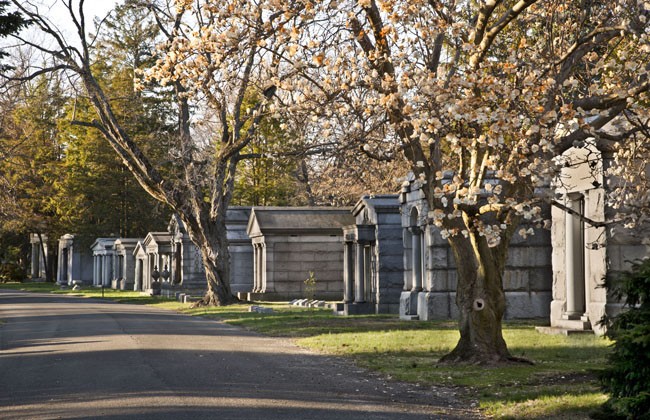Sylvan Cemetery: Architecture, Art and Landscape at Woodlawn
Sylvan Cemetery highlights the renowned architects, artists, artisans and landscape designers whose work has come to define Woodlawn Cemetery, which was designated a National Historic Landmark in 2011 for the significance of its art and architecture. Through the display of preparatory and design drawings and sketches, maps, building elevations, early photographs, maintenance records and letters, the exhibition will examine Woodlawn's creation in 1863, its response and adaptation to changing ideas about memorial monuments and commemorative landscapes since then and its role in defining the art, architecture and landscape of American cemeteries.
SELECTED WORKS
Image Carousel with 13 slides
A carousel is a rotating set of images. Use the previous and next buttons to change the displayed slide
-
Slide 1: 1921 Aerial view of Woodlawn Cemetery by the Jerome Avenue gates. Avery Library, Drawings & Archives, Woodlawn Cemetery Records.
-
Slide 2: The second published map of Woodlawn (1868) signed by R.E.K. Whiting, who was in charge of the development of Woodlawn Cemetery until his death in 1871. This map shows the 300 foot square grid that is the basis for Woodlawn cartography. Avery Library, Drawings & Archives, Woodlawn Cemetery Records.
-
Slide 3: Architect Charles B. Atwood designed this gateway for Woodlawn. Atwood is best known for designing structures at the World's Columbian Exposition of 1893 in Chicago. Avery Library, Drawings & Archives, Woodlawn Cemetery Records.
-
Slide 4: Portrait of Absalom Peters, an American clergyman and the founder of the Woodlawn Cemetery. Born Wentworth, New Hampshire, September 19, 1793, died New York City, May 27, 1869. Private collection.
-
Slide 5: A view of Harbeck mausoleum illuminated at night. Photograph by Gavin Ashworth.
-
Slide 6: The Christ in Majesty window made by Tiffany Studios for Harbeck mausoleum, ca. 1917 is a highlight of the exhibition. Photograph by Gavin Ashworth. Courtesy The Woodlawn Cemetery.
-
Slide 7: Monument and bird bath designed by James Gamble Rogers (architect of Butler Library) in 1939 for the Edward and Millie Kuhn lot in Knollwood plot. Avery Library, Drawings & Archives, Woodlawn Cemetery Records.
-
Slide 8: This detail from a drawing of a memorial to the English actor James Hackett illustrates one of only two structures in the United States by the renowned British architect Edwin Lutyens. The British Embassy in Washington is the other. Avery Library, Drawings & Archives, Woodlawn Cemetery Records.
-
Slide 9: Drawing for the bronze and black granite Romney memorial located in Golden Rod plot by Alexander Archipenko. Avery Library, Drawings & Archives, Woodlawn Cemetery Records.
-
Slide 10: Richard Plumb carving a clay model of mounded circles c. 1940. Designs for new plots that followed the pre-World War II pattern of large circles were revised to accommodate smaller repetitive lots after the war. Avery Library, Drawings & Archives, Woodlawn Cemetery Records.
-
Slide 11: View of Woodlawn Cemetery in the fall. Photograph by Gavin Ashworth. Courtesy The Woodlawn Cemetery.
-
Slide 12: Large circles in Hawthorn and Lakeview Plots with the William Hall obelisk in the foreground and the Jay Gould mausoleum in the distance at left. Gould's is the largest circular lot at Woodlawn. Photograph by Gavin Ashworth.
-
Slide 13: Park Avenue lined with modestly-scaled mausoleums set close together on small lots. Photograph by Gavin Ashworth. Courtesy The Woodlawn Cemetery.
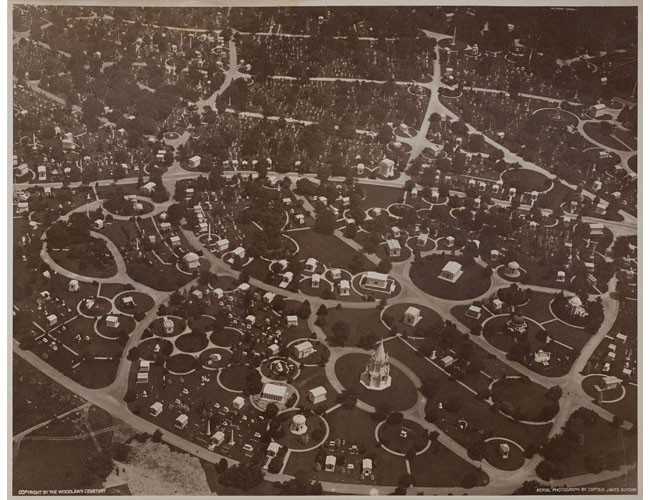
1921 Aerial view of Woodlawn Cemetery by the Jerome Avenue gates. Avery Library, Drawings & Archives, Woodlawn Cemetery Records.
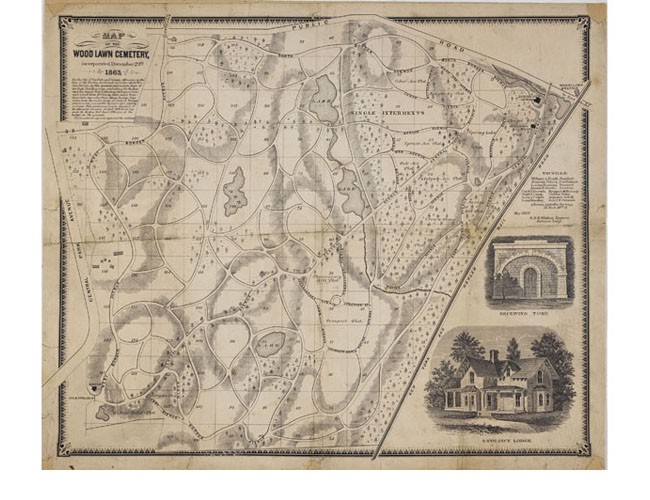
The second published map of Woodlawn (1868) signed by R.E.K. Whiting, who was in charge of the development of Woodlawn Cemetery until his death in 1871. This map shows the 300 foot square grid that is the basis for Woodlawn cartography. Avery Library, Drawings & Archives, Woodlawn Cemetery Records.
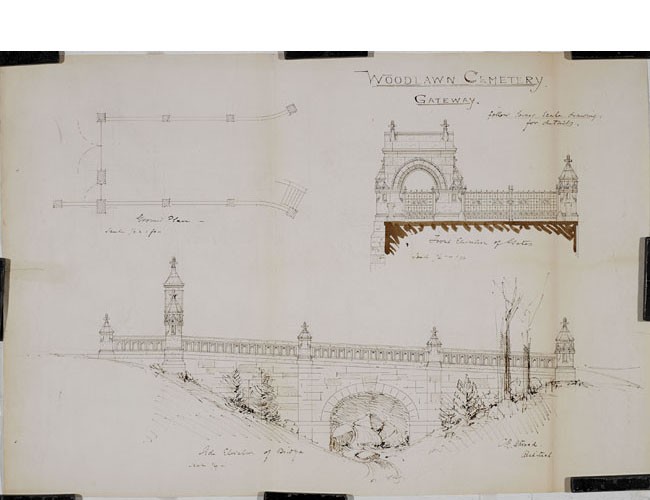
Architect Charles B. Atwood designed this gateway for Woodlawn. Atwood is best known for designing structures at the World's Columbian Exposition of 1893 in Chicago. Avery Library, Drawings & Archives, Woodlawn Cemetery Records.
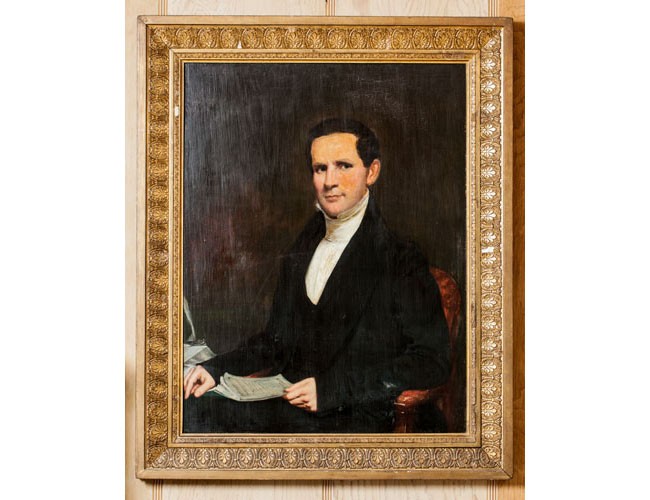
Portrait of Absalom Peters, an American clergyman and the founder of the Woodlawn Cemetery. Born Wentworth, New Hampshire, September 19, 1793, died New York City, May 27, 1869. Private collection.
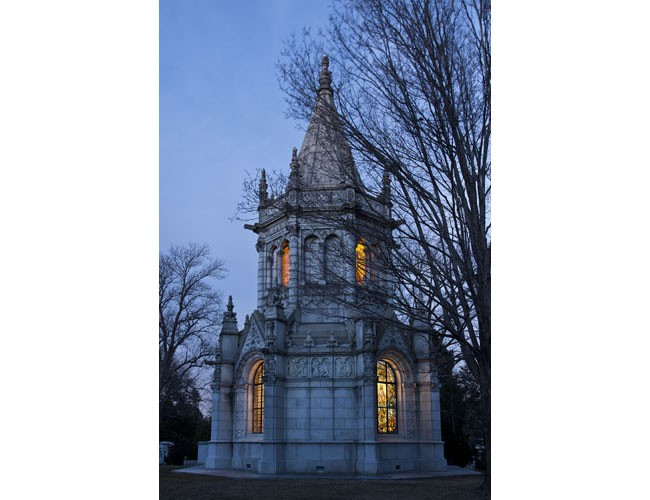
A view of Harbeck mausoleum illuminated at night. Photograph by Gavin Ashworth.
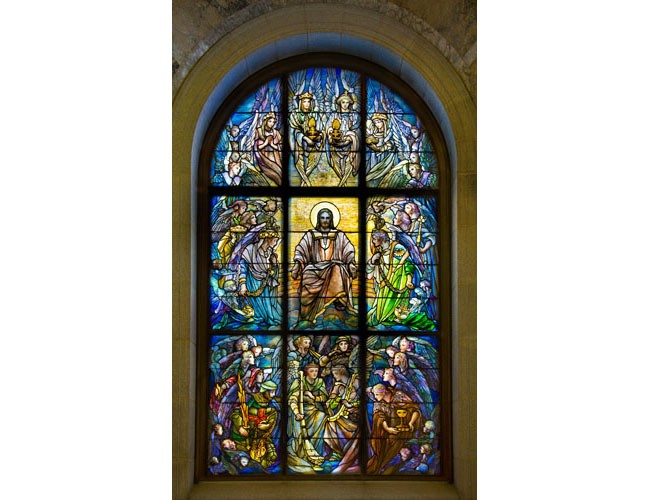
The Christ in Majesty window made by Tiffany Studios for Harbeck mausoleum, ca. 1917 is a highlight of the exhibition. Photograph by Gavin Ashworth. Courtesy The Woodlawn Cemetery.
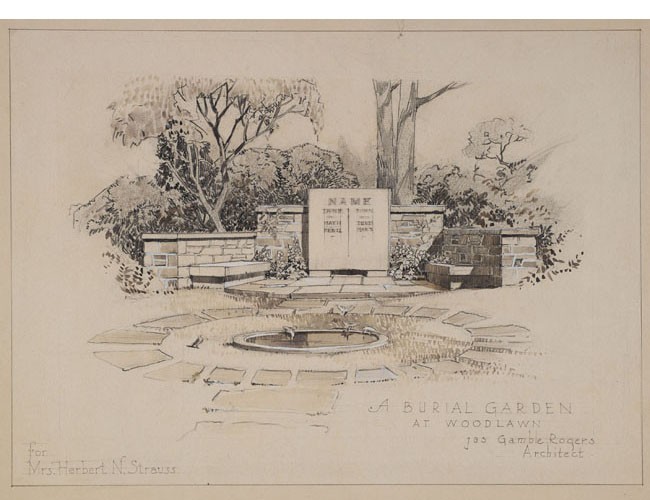
Monument and bird bath designed by James Gamble Rogers (architect of Butler Library) in 1939 for the Edward and Millie Kuhn lot in Knollwood plot. Avery Library, Drawings & Archives, Woodlawn Cemetery Records.
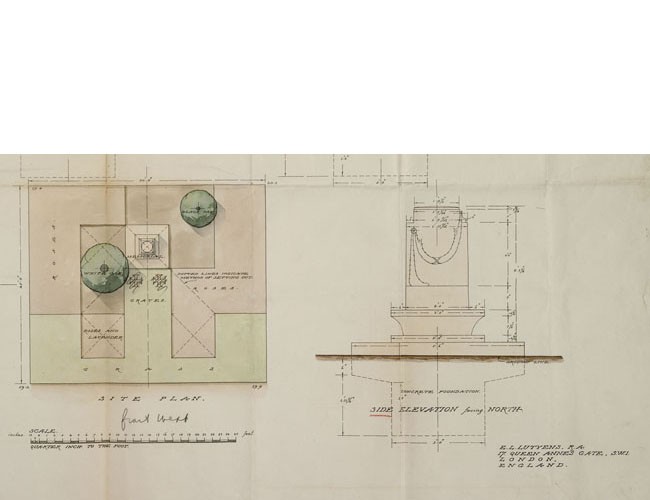
This detail from a drawing of a memorial to the English actor James Hackett illustrates one of only two structures in the United States by the renowned British architect Edwin Lutyens. The British Embassy in Washington is the other. Avery Library, Drawings & Archives, Woodlawn Cemetery Records.
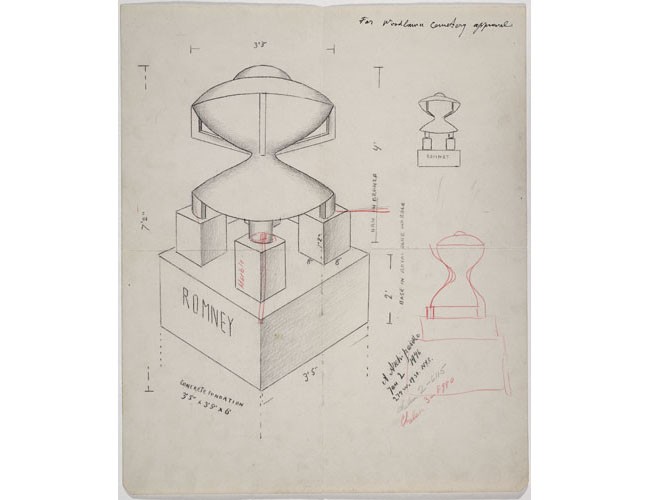
Drawing for the bronze and black granite Romney memorial located in Golden Rod plot by Alexander Archipenko. Avery Library, Drawings & Archives, Woodlawn Cemetery Records.
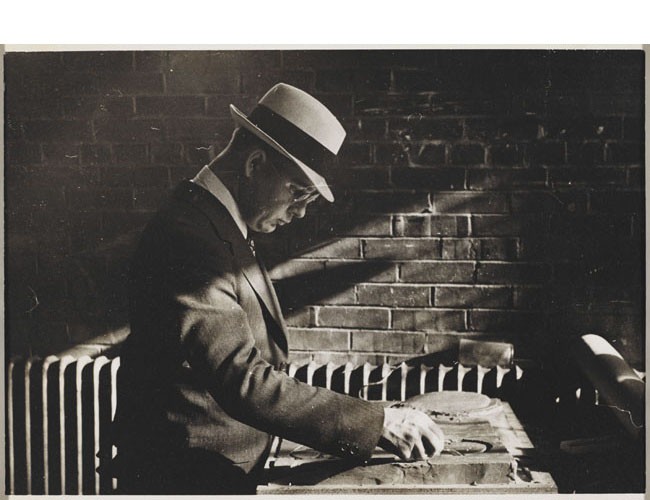
Richard Plumb carving a clay model of mounded circles c. 1940. Designs for new plots that followed the pre-World War II pattern of large circles were revised to accommodate smaller repetitive lots after the war. Avery Library, Drawings & Archives, Woodlawn Cemetery Records.
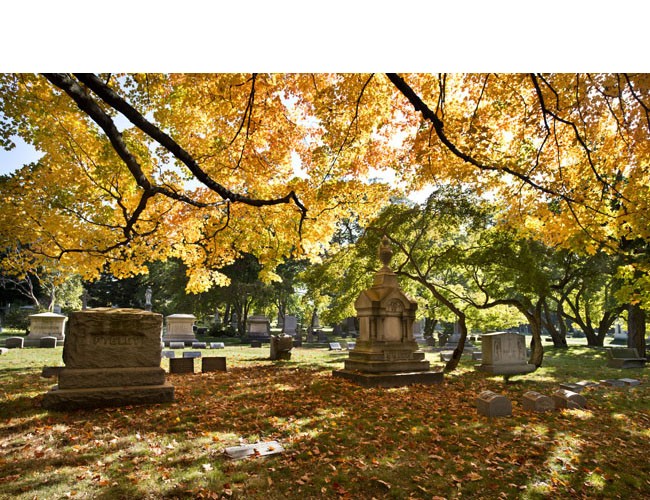
View of Woodlawn Cemetery in the fall. Photograph by Gavin Ashworth. Courtesy The Woodlawn Cemetery.
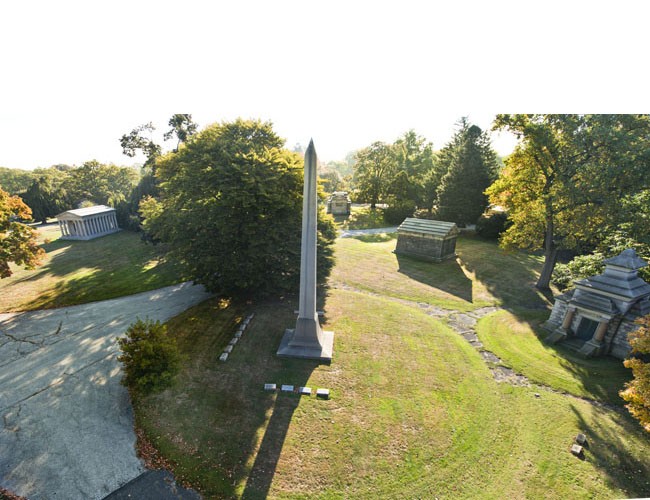
Large circles in Hawthorn and Lakeview Plots with the William Hall obelisk in the foreground and the Jay Gould mausoleum in the distance at left. Gould's is the largest circular lot at Woodlawn. Photograph by Gavin Ashworth.
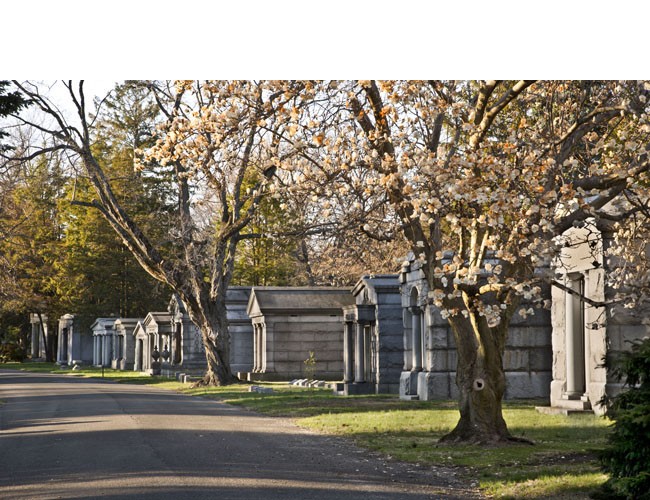
Park Avenue lined with modestly-scaled mausoleums set close together on small lots. Photograph by Gavin Ashworth. Courtesy The Woodlawn Cemetery.
Key objects in the exhibition include: a door from the Straus Mausoleum–the final resting place of Isidor and Ida Straus, who perished during the sinking of the Titanic–created by metalworker Samuel Yellin; a maquette of the Vernon Castle Memorial by sculptor Sally Farnham and a stained glass window by Tiffany Studios, from the Harbeck Mausoleum.
Woodlawn exemplifies the landscape-lawn style of cemetery that became popular after the Civil War. The park-like setting encouraged the creation of freestanding monuments and mausoleums, which wealthy New Yorkers commissioned the leading architects to design and the era's best-known artists and craftsmen to embellish. In the process, fine art sculpture, metalwork and stained glass became central to Woodlawn's landscape and influenced memorials at other American cemeteries. Featured in Sylvan Cemetery will be the work of landscape designers Beatrix Farrand, the Olmsted Brothers and Ellen Biddle Shipman; architects McKim, Mead, & White, Carrère & Hastings and John Russell Pope; as well as craftsmen and artists Rafael Guastavino and son Rafael, Jr., Louis Comfort Tiffany, John LaFarge, Samuel Yellin and Alexander Archipenko.
"The creation of Woodlawn is a classic New York story of money, real estate, art and familial relationships," said exhibition co–curator and Woodlawn Cemetery's historian Susan Olsen. "It is also a national story, which started in the industrial age and goes through today, as prominent Americans continue to choose Woodlawn as their final resting place. This story is written into our landscape and is on view for anyone who visits our monuments and gravesites."

